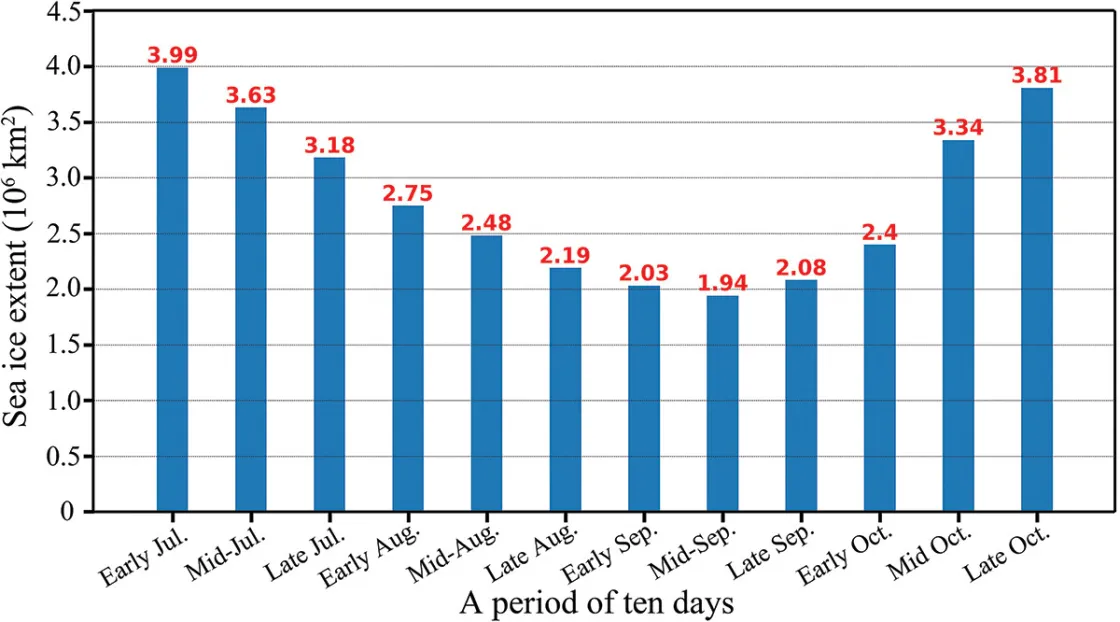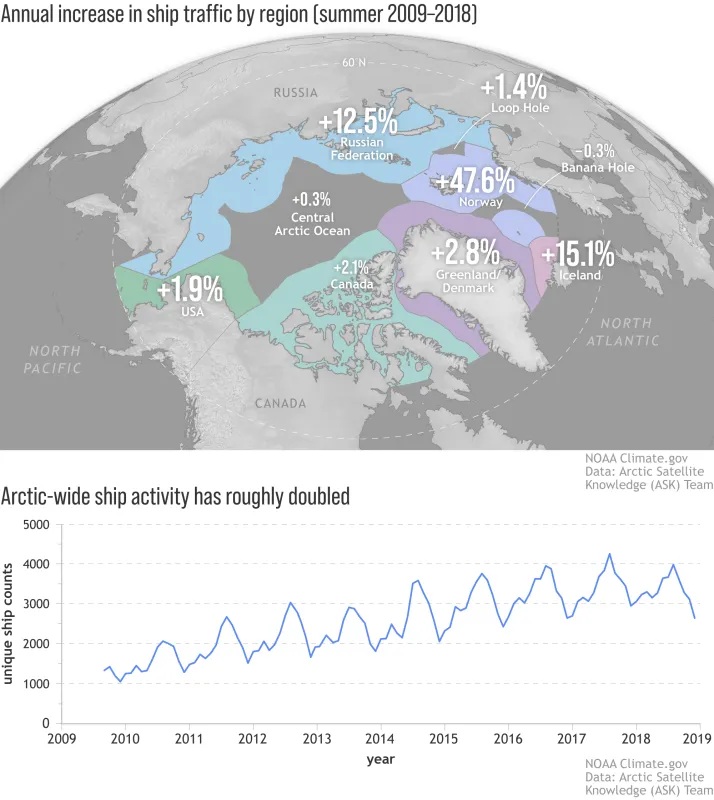By Michon Scott
The Northeast Passage is a shipping route north of Eurasia, connecting the Barents Sea north of Scandinavia to the Bering Strait between the Russian Far East and Alaska. Even today, this dangerous trade route has remained so choked with sea ice that the safest year-round ways to navigate it are by plowing through it with an icebreaker, or going underneath it in a submarine. As Arctic sea ice has retreated, interest has grown in navigating a greater variety of ships through the passage, whether for commercial, recreational, or military purposes.
Conditions vary from year to year, and no part of the Northeast Passage is guaranteed to be ice free at any particular time. Still, a paper published in 2023, using data archived at NSIDC, identified the time of year when ships are the likeliest to succeed in negotiating the route. The best window of opportunity occurs in mid-September, when Arctic sea ice reaches its minimum extent for the year.
Reliable data minimize risks
As long ago as the sixteenth century, European traders hoped for an Arctic shortcut to Asia, but the Northeast Passage foiled navigation efforts for many years. Explorer Adolf Erik Nordenskiöld finally succeeded in traversing the Northeast Passage in 1879, after spending 10 months of the voyage locked in ice. He returned to a hero’s welcome in Stockholm in 1880. (Navigation of the Northwest Passage through the Canadian Archipelago defied explorers even longer, only completed by Norwegian Roald Amundsen in 1906.)
During the Cold War, superpowers on both sides of the Atlantic prepared for the possibility of warfare waged at least partly in the frozen north. Submarines took observations from under the ice, a process that continued even after open hostilities ceased. After the Cold War ended, some of the observations collected during that time were declassified and shared. The National Oceanic and Atmospheric Administration program at NSIDC (NOAA@NSIDC) also offers several decades of sea ice charts and ice edge locations in the Russian Arctic, spanning 1933 to 2006. These decades-long data sets provide a basis for projections of future sea ice behavior.
Sea ice retreat has recently made the Arctic Ocean more alluring—both to political entities intent on resource extraction and military operations, and to commercial interests eager to move people and cargo across the region. The Arctic remains a challenging environment, however, with an ever-present possibility of accidents requiring cleanup and rescue. Success in the Arctic often comes down to smart timing. Robust predictions of where and when sea ice is likely to impede shipping depend on reliable data.
The 2023 study on the optimal timing of Northeast Passage relied on two data sets from the National Snow and Ice Data Center NASA Distributed Active Archive Center (NSIDC DAAC). One includes daily brightness temperatures from passive microwave satellite sensors, and the other includes brightness temperature, sea ice concentration, and snow depth. Satellite observations of brightness temperature—a measure of the energy emitted by a surface—enable scientists to identify different kinds of icy and watery surfaces. With brightness temperature observations, scientists can detect surface melt on sea ice and even distinguish between relatively thin first-year ice and thicker multiyear ice. Both thin ice and melting ice present fewer obstacles to ship navigation, so identifying ice features helps determine the best routes to take, and the best times to take them.
Best time to try
Arctic sea ice has declined since the start of the satellite record in 1979. Consequently, Arctic Ocean navigation that was unthinkable during most of the twentieth century is more practical now—but only for part of the year.
The window of opportunity for non-icebreaker ships crossing the Northeast Passage opens in summer and closes in autumn. While this general timing has been widely known in recent years, the 2023 study on the Northeast Passage has refined our current understanding. It pinpointed the optimal shipping window by examining conditions in the Northeast Passage from 2002 through 2021. The study found that sea ice in the Arctic Ocean generally begins melting in earnest in June or July, and refreezing in October. Sea ice extent—the area of ocean with at least 15 percent sea ice concentration—bottoms out in mid-September. From 2002 to 2021, sea ice in the area examined in the 2023 study (see the Northeast Passage study area map above) averaged 1.94 million square kilometers (363,000 square miles). For comparison, that area equals a little more than twice the size of California. The bottomed-out time of year in the Northeast Passage correlates with the general timing of the Arctic sea ice minimum.
As the Arctic continues to warm, the Northeast Passage will likely experience more late-summer stretches of relatively ice-free water. Yet highly concentrated ice still prevents navigation through the Northeast Passage most of the year, unless crossing is made with an icebreaker. Further complicating human activities above the Arctic Circle, the Sun sets below the horizon in October and does not reemerge until March. So even though sea ice presents less of an obstacle than it used to in earlier decades, the Northeast Passage, like the entire Arctic Ocean, will remain a complicated place in which to work.
References
Pang, X., C. Zhang, Q. Ji, Y. Chen, Z. Zhen, Y. Zhu, and Z. Yan. 2023. Analysis of sea ice conditions and navigability in the Arctic Northeast Passage during the summer from 2002-2021. Geo-spatial Information Science 26(3):465-479. https://doi.org/10.1080/10095020.2022.2124128.
Encyclopedia Britannica. Northeast Passage. Accessed April 14, 2024.
Linda Hall Library. 2015. Scientist of the Day: Adolf Erik Nordenskiöld. Accessed April 14, 2024.
Data sets available through the NSIDC DAAC and NOAA@NSIDC
NSIDC archives a variety of data sets, on behalf of NASA and NOAA, and the 2023 Northeast Passage study is just one example of many where NSIDC-provided data sets have been essential. In addition to archiving data, NSIDC provides data users with multiple methods of support: documentation, help articles, data tools, training, and on-demand support.
Arctic and Antarctic Research Institute. Compiled by V. Smolyanitsky, V. Borodachev, A. Mahoney, F. Fetterer, and R.G. Barry. 2007. Sea Ice Charts of the Russian Arctic in Gridded Format, 1933-2006, Version 1 [Data Set]. Boulder, Colorado USA. National Snow and Ice Data Center. https://doi.org/10.7265/N5D21VHJ.
Bliss, A. C., M. Anderson, and S. Drobot. 2022. Snow Melt Onset Over Arctic Sea Ice from SMMR and SSM/I-SSMIS Brightness Temperatures, Version 5 [Data Set]. Boulder, Colorado USA. NASA National Snow and Ice Data Center Distributed Active Archive Center. https://doi.org/10.5067/TRGWQ0ONTQG5.
Cavalieri, D. J., T. Markus, and J.C. Comiso. 2014. AMSR-E/Aqua Daily L3 12.5 km Brightness Temperature, Sea Ice Concentration, & Snow Depth Polar Grids, Version 3 [Data Set]. Boulder, Colorado USA. NASA National Snow and Ice Data Center Distributed Active Archive Center. https://doi.org/10.5067/AMSR-E/AE_SI12.003.
Mahoney, A. 2008. Sea Ice Edge Location and Extent in the Russian Arctic, 1933-2006, Version 1 [Data Set]. Boulder, Colorado USA. National Snow and Ice Data Center. https://doi.org/10.7265/N5W37T8Z.
Meier, W.N., J.S. Stewart, H. Wilcox, D.J. Scott, and M.A. Hardman. 2021. DMSP SSM/I-SSMIS Daily Polar Gridded Brightness Temperatures, Version 6 [Data Set]. Boulder, Colorado USA. NASA National Snow and Ice Data Center Distributed Active Archive Center. https://doi.org/10.5067/MXJL42WSXTS1.
Steele, M., A. C. Bliss, G. Peng, W. N. Meier, and S. Dickinson. 2019. Arctic Sea Ice Seasonal Change and Melt/Freeze Climate Indicators from Satellite Data, Version 1 [Data Set]. Boulder, Colorado USA. NASA National Snow and Ice Data Center Distributed Active Archive Center. https://doi.org/10.5067/KINANQKEZI4T.




